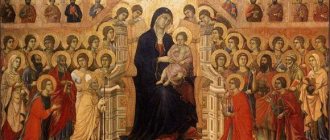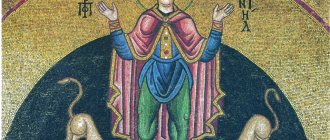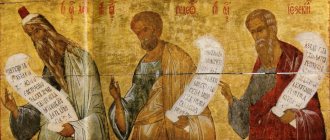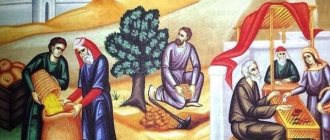Every Christian treats the Bible as a sacred object, unconditionally believing in every word of it. And this is correct, however, let’s be honest, there are some events described in Holy Scripture, the actions of which do not fit into our minds. How could Lazarus, who had already begun to decompose, come to life? How was Jesus resurrected in a human body? What did the prophet Jonah breathe for three days in the belly of the whale?
It is the book of the prophet Jonah that causes the most controversy, whether it is a myth or truth that a man was swallowed by a fish, and he survived after that.
Jonah's Story
This happened in the eighth century BC. Nineveh was a city in the Assyrian state, the “glory” of whose dissolute, cruel people was known to everyone. The vile actions of the Ninevites angered God, but His love for the people was greater than His judgment.
The capital of Assyria is Nineveh
The Creator chose the prophet Jonah with a mission to send messages to the evil inhabitants of Nineveh that if they do not stop their outrages, God will destroy the city.
Fear took possession of the messenger of God, and he decided to flee to another country by boarding a ship. During the journey, a huge storm covered the ship, the sailors realized that this was the wrath of God and began to look for the culprit, Jonah admitted that it was he who was thrown overboard.
According to God, the prophet was swallowed by a whale, kept him there for 3 days and spat him out. (Matthew 12:40)
The whale threw Jonah onto the shore of Nineveh
Sounds like a fairy tale or myth. Jonah prayed in the belly of the whale, of course, during this time he realized how dangerous it was not to carry out the orders of the Almighty.
How often do we, people, read the word of God, understand that we are going the wrong way, but stubbornly do things that are displeasing to God, and then, when we get into problems, we shout and cry out to the Creator.
Attention! The story of Jonah is intended to teach Christians to listen to the commands of the Lord from the first time, to follow His Providence.
The prophet reached Nineveh, fearfully conveyed God's message, expecting death for the bad news. His surprise knew no end when the whole city dressed in rags, a fast was declared for three days, when they did not even drink water, people sprinkled ashes on their hair and prayed to the Creator for mercy.
These days Jonah sat under the walls of the city, in the shade of a thick tree, and waited for God's punishment. The loving Lord saw the sincere repentance of the Ninevites and gave them life. Nineveh stood for another 100 years, after which it was destroyed.
The mercy of the Lord caused bewilderment among the prophet. He was also outraged by the fact that the tree that provided shade, according to the word of God, dried up in an instant, to which God gave an answer. The Creator told the prophet that he pitied the tree that he did not plant. The Lord created the people of the city, these are His creations, how could He destroy them, seeing repentance.
Important! A wonderful sign for everyone living on earth - God always answers sincere prayers and forgets sin after sincere repentance.
About spiritual life:
- What is mercy
- What is humility
- How to consecrate an icon
The story of Jonah is the amazing tale of a wayward prophet who, after being swallowed by a whale (or "big fish" - see below) and vomited ashore, reluctantly led the wicked city of Nineveh to repentance. Skeptics often criticize this biblical account because of the incredible events described in it. These events include the following:
• Mediterranean storm caused and calmed by God (Jonah 1:4-16)
• a large fish sent by God to swallow the prophet after he was thrown into the sea by the ship's crew (2:1)
• Jonah's survival in the fish's stomach for three days and three nights, or his resurrection from the dead after being vomited onto the shore - depending on how you interpret the text (2:1)
• the fish spewing Jonah onto the shore at God's command (2:11)
• a plant that grew very quickly in God's providence to give Jonah shade (4:6)
• a worm sent by God to eat away and cause the plant that gives shade to wither (4:7)
• a hot wind caused by God to make Jonah uncomfortable (4:8).
Critics also consider Nineveh's repentance unlikely (3:4-9), although it is not technically a miracle. However, Nineveh's repentance makes sense given the extraordinary appearance of Jonah on the Mediterranean coast and the fact that we know of the worship of Dagon in that particular area of the ancient world. Dagon was a fish god, a popular deity among the pantheons of Mesopotamia and the eastern Mediterranean. He is mentioned several times in the Bible in relation to the Philistines (Judges 16:23-24; 1 Samuel 5:1-7; 1 Chronicles 10:8-12). Images of Dagon have been found in palaces and temples of Nineveh and throughout the region. In some cases he was represented as a man dressed as a fish. In others, he was half man, half fish - a kind of merman or mermaid.
Regarding Jonah's success in Nineveh, the orientalist Henry Clay Trumbull made a legitimate argument when he wrote the following: “What could be more convincing for Jonah as a divine messenger to Nineveh than to be thrown out of the mouth of a great fish in the presence of witnesses somewhere on the coast of Phoenicia, where the fish god was a favorite object of worship? Such an incident would inevitably excite the vivid imagination of the Eastern spectators, so that many would be ready to follow the one whom they considered to be the incarnation of the fish god, who told them the story of his rise from the sea and was going on a mission to the city in which the fish god was the center of worship " (G. Clay Trumbull, Jonah at Nineveh, Journal of Biblical Literature, Vol. 2, No. 1, 1892, p. 56).
Some researchers suggest that Jonah's appearance, discolored by the fish's stomach acids, contributed to his mission. If so, then the Ninevites encountered a man whose skin, hair, and clothing were a ghostly white—a man accompanied by a crowd of frenzied followers, many of whom claimed to have witnessed him being spat ashore by a large fish (plus any colorful exaggerations , which they might have added).
Jonah only had to cause a public outcry to gain access to the king, who, having heard of the divine verdict, would have the power to proclaim a day of fasting and repentance in the city. According to the biblical account, this is exactly what happened (Jonah 3:6-9). So, given that the prophet was cast ashore by a large fish, Nineveh's repentance follows a completely logical progression.
Regarding Jonah's experience at sea (which is the most difficult issue in this story), although there is no conclusive historical evidence that he was ever swallowed by a fish and lived to tell the tale, there is some startling evidence to support it. In the third century BC. a Babylonian priest/historian named Berossus wrote about a mythical creature named Oannes who emerged from the sea to bring divine wisdom to the people. Scholars generally identify this mysterious fish-man as an avatar of the Babylonian water god Ea (also known as Enki). A curious point in Berossus's story is the name he used: Oannes.
Berossus wrote in Greek during the Hellenistic era. The name Oannes is only one letter shorter than the Greek name John. John is one of two Greek names used in the New Testament for the Hebrew name Jonah, which in turn is short for Yochanan. Both John and Jonas (the second Greek equivalent name) are used interchangeably in the Septuagint, the Greek translation of the Hebrew Old Testament. (Compare 2 Kings 25:23 and 1 Chronicles 3:24 in the Septuagint with the same passages in the Hebrew Old Testament.)
As for the missing “i” in the name Oannes, then, according to Professor Trumbull, who claims that his conclusions were confirmed by the famous Assyriologist Dr. Herman Hilprecht, “In Assyrian writings, the “y” from foreign words is transformed into “and” or disappears altogether; therefore Yoann, the Greek counterpart of Jonah, will be called by the Assyrians either John or Oannes” (ibid., p. 58).
Nineveh was an Assyrian city. This essentially means that Berossus wrote about a fish-man named Jonah emerging from the sea to impart divine wisdom to the people—a remarkable confirmation of the Hebrew narrative.
Berossus claimed to have based his description on official Babylonian sources. Nineveh was conquered by the Babylonians under King Nabopolassar in 612 BC, more than 300 years before Berossus. It is therefore very likely, at least hypothetically, that his writings describe Jonah's successes in Nineveh. If this is true, then Jonah appears to have been deified and mythologized for three centuries, first by the Assyrians, who no doubt associated him with their fish god Dagon, and then by the Babylonians, who seem to have associated him with their own god of water Ea.
In addition to Berossus's account, Jonah appears in the Israelite chronicles as the prophet who predicted the military successes of Jeroboam II against Syria in the 8th century BC (2 Kings 14:25). Jonah is believed to have been the son of Amathiah (see Jonah 1:1) from the city of Gath-Hepher in lower Galilee. Josephus repeats these details in his Antiquities of the Jews (chapter 10, paragraph 2). Jonah was not an imaginary person invented to play the role of a disobedient prophet who was swallowed by a fish. He is part of the prophetic history of Israel.
Regarding the city of Nineveh, it was rediscovered in the 19th century after over 2,500 years of oblivion. It is now believed that it was the largest city in the world at the time of its disappearance (see Four Millennia of Urban Development: A Historical Census by Tertius Chandler). According to Sir Austin Henry Layard, who described the discovery of this city, the circumference of Greater Nineveh was "exactly three days' journey", as stated in Jonah 3:3 (Austen Henry Layard, A Popular Account of the Discoveries at Nineveh, 1854, p. 314 ). Before this discovery, skeptics scoffed at the fact that such a large city could exist in the ancient world. Many denied the existence of Nineveh altogether. Its rediscovery in the mid-1800s provided remarkable evidence for the Bible, which mentions Nineveh 18 times and devotes two entire books to its fate (Jonah and Nahum).
It is interesting to note where the lost city of Nineveh was discovered. He was found buried under several mounds in the vicinity of Mosul in modern Iraq. These mounds are known by their local names, Kuyundzhik and Nabi-Yunus. Nabi Yunus, as it turns out, means “prophet Jonah” in Arabic. The lost city of Nineveh was found buried under a mound named after the prophet Jonah.
Regarding the whale, the Bible does not actually specify what sea animal swallowed Jonah. Most researchers believe that it was a sperm whale. It could also be a white shark. The Hebrew phrase used in the Old Testament, “gadovl dag,” literally means “big fish.” The Greek word used in the New Testament, ketos, simply means “sea creature.” At least two species of Mediterranean inhabitants are known that can completely swallow a person - the sperm whale and the white shark. Both of these creatures were found in various places in the Mediterranean Sea and have long been known to Mediterranean sailors. Aristotle described both of these species in his History of Animals back in the 4th century AD.
So we have three of the four key players in the story: Jonah, Nineveh, and the fish that could swallow a man. That leaves a fourth character: God. Skeptics scoff at the miracles described in the book of Jonah, arguing that there is no mechanism by which such events could occur. This is their prejudice. However, we know that there is One who is able to control natural phenomena in such a supernatural way. We believe that He is the Creator of the natural kingdom and is therefore not limited by it. We call Him God and believe that He sent Jonah to Nineveh to bring that city to repentance.
God has revealed Himself throughout history in various ways, one of which was His incarnation in the Person of Jesus Christ. Jesus not only gives us reason to believe that there is someone who can perform miracles, He gives us confidence that such events actually happened.
Jesus spoke of Jonah's trial as a real historical event. He used it as a metaphor for His own crucifixion and resurrection, which were incredible events in themselves. Matthew quoted Jesus as saying: “Just as Jonah remained in the belly of the sea monster for three days and three nights, so the Son of man will remain in the bowels of the earth for three days and three nights. The people of Nineveh will stand with the people of this generation on the Day of Judgment and blame him: after all, they repented after hearing Jonah's preaching. And here is something greater than Jonah!” (Matthew 12:40-41; Russian Bible Society translation; cf. Luke 11:29-30, 32).
The evidence is that every Christian can have a basis for faith, and every skeptic should think twice before dismissing the story of Jonah as a myth.
Reality or fairy tale
The position of the Orthodox Church on this issue is clear; it places the emphasis not on a miracle, but on the mercy of God, who saved Jonah and Nineveh.
Prophet Jonah
For some reason, everyone believes that a huge tree that provided shade for an adult can dry up in one day, but it is impossible to survive in the belly of a whale. The world of scientists does not take anything for granted; it needs evidence and examples.
The Hebrew does not say anything about Jonah being swallowed by a whale, it says that it was a living monster. Ancient pictures began to depict the blue whale as a sea monster, perhaps due to the huge size of the whale.
Back then, people did not know that a whale’s throat was not capable of swallowing even a large orange. The blue whale feeds on small shrimp and krill, hence the mistrust of the message of the prophet Jonah. The sperm whale with its huge mouth, which thoroughly chews its food, could not swallow the prophet either, so in this case Jonah had no chance of life.
The fin whale was of particular interest to scientists. This giant sometimes reaches 25 meters in length, but the most interesting thing is that its stomach is divided into 6 chambers, and in its head there is a chamber with air through which the huge sea monster breathes. The catching process looks like this: first, the swallowed food enters the air chamber, and from there into the stomach.
The fin whale is a relative of the blue whale and the second largest animal on the planet.
By the way, the size of the chamber is almost 200 cubic meters, so Jonah could easily stay there for three days.
The notes of the English doctor Ranson Harvey describe how his friend decided to check the veracity of the story and climbed into the air space of the dead whale, confirming that the air filling the chamber was quite enough to support human life for three days.
More about miracles in Orthodoxy:
- Barnaul miracle of Claudia Ustyuzhanina
- Miracles in Orthodoxy
- Miracles and help of the Mother of God










